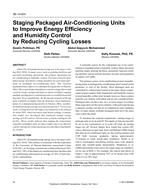Description
About 9% of manufacturing energy use is for space cooling (EIA 2010). In many cases, such as printing facilities and precision machining operations, the primary motivation for air conditioning is humidity control. Previous research identified energy and latent cooling penalties for part-load operation of packaged air-conditioning units. This research quantified those effects in a manufacturing facility in Dayton, Ohio.The research then identified a control strategy that would result in energy savings and improve latent cooling by staging multiple packaged air-conditioning units to establish lead and lag units. To accomplish this, the thermostat setpoint of the lag units would be set higher than the lead unit. Upon implementation in a manufacturing facility in Dayton, Ohio, weathernormalized energy savings were measured to be 4.7% over one week. Cycling between all stages was measured to be reduced by about 50%, which increases total latent cooling. A simulation model was developed that predicted annual energy savings of 4.6% and an 18% increase in latent cooling for the facility. These results indicate that staging the temperature setpoints of multiple units serving a single zone is an effective control strategy for reducing energy use and improving humidity control.
Citation: ASHRAE Transactions – Volume 120, Part 2, Seattle, WA
Product Details
- Published:
- 2014
- Number of Pages:
- 8
- File Size:
- 1 file , 2.4 MB
- Product Code(s):
- D-SE-14-004




